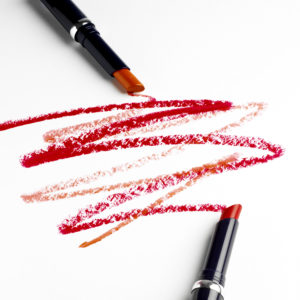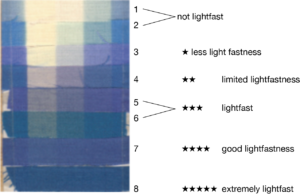 Pigments is a group of compound insoluble in a medium in which it is to be used. Major function of which is to improve the appearance or give color to the other materials. It must be stable in solid form at ambient temperatures
Pigments is a group of compound insoluble in a medium in which it is to be used. Major function of which is to improve the appearance or give color to the other materials. It must be stable in solid form at ambient temperatures
The main features that contribute together to define a pigment are of chemical nature (basic composition, additives, impurities), and physical nature (crystalline structure, colour, index of refraction, form, dimension and state of aggregation of the particles, specific weight). All these data, mostly interdependent with each other, have a decisive influence on the pigment performance, that combine to calculate the pigments and application characteristics. Most important are: colour, covering power or matting, coloring power, disperdibility, brilliance, resistance to the light, to the heat, to chemical agents. Pigments are classified as either organic or inorganic:
– Organic pigments are based on carbon chains and carbon rings. However, they can also contain metallic (inorganic) elements that help to stabilize the properties of the organic components.
– Inorganic pigments, chemical compounds not based on carbon, are usually metallic salts precipitated from solutions.
Inorganic pigments can be defined as insoluble compounds with a basis of metallic ions. Metallic ions are generally elements of transition such as iron, titanium or chrome and their structures are often three-dimensional. Typical examples of inorganic pigments used in a lipstick are iron oxides, titanium dioxide, mica covered in titanium dioxide and bismuth oxychloride. The overall stability of inorganic pigments is good, even if in certain conditions they may sustain chemical reactions due to acidity and alkalinity. Inorganic pigments have a much larger average particle size than organic pigments. The optimum particle size needed to achieve maximum light scattering – resulting in opacity – is between 400 and 800 nm (wavelength). The particles sizes of inorganic pigment are much closer to this optimum that those of inorganic pigments. This is the main reason why most organic pigments are considered transparent and most inorganic pigments opaque. With their larger surface area, organic pigments give much higher color strength. However, for similar reasons, their disperdibility is usually poorer.
Organic pigments can be divided into three groups: 1) lakes that are water-soluble colorants absorbed in alumina; 2) products to provide shading that are organic barium or calcium salts; 3) real pigments that do not contain metallic ions, that are, in fact, more stable. These are followed by products to provide shading, while aluminum lakes are less stable. Examples of organic pigments are: lakes: D&C RED NO.27 (CI 45410:2) aluminum lake; products to provide shading: D&C RED NO.7 (CI 15850:1) calcium lake; real pigments D&C RED NO.6 (CI 15850). (tab. A)
Tabella A
| Pigments stability expressed using the BWS | |
| D&C Red N.7 Ca Lake | 5 |
| D&C Red N.6 | 7 |
| D&C Red N.6 Ba Lake | 5 |
| D&C Red N.27 Al Lake | 3÷4 |
Factors that influence the stability
Some factors that may influence the stability of the pigments are photolytic action of light (lightfastness), heat, metallic ions, physical processes and microorganism.
Lightfastness
Exposure to light can cause electronic transitions within a molecule whose final result is the breakdown of bonds, which may destroy the molecule itself, causing a loss of color or discoloration. It is a property mainly connected to the chemical composition of pigments, very important but also complex. In fact, it should be valued, rather than in relation to pure pigment, at the pigment in the final formulation or, better still, after the application. Inorganic pigments are generally very resistant to the effects of light because the energy required to generate a breakdown of bonds is greater than that provided by sunlight. Exceptions are provided by bismuth oxychloride (BIOCl) and by those titanate micas containing organic molecules. When exposed to sun light, bismuth oxychloride converts into elementary bismuth which has the effect of making white powder gray. The stability of organic pigments under light shows that real pigments are the most stable, products providing shading have medium stability and aluminum lakes are considered unstable products. In practice the aluminum lacquers are not recommended for the products in which it is expected prolonged exposure to light. The presence of special oil or UV filters oils imparts a certain degree of protection from the photolysis; on the contrary, some pigments may affect the lightfastness of other pigments or colorants promoting the photolysis, such as titanium white and iron oxide that cause photodegradation of some organic pigments, acting as photocatalysts.
Heat
Ambient temperatures are usually not high enough to affect colors. The process of manufacturing lipstick is, however, carried out at temperatures that are high enough to adversely affect some colors, often causing changes in shades. It is therefore important to keep the time of exposure to heat at minimum levels and add the colors as late as possible in the manufacturing process. The majority of inorganic pigments is manufactured at high temperature and is therefore generally not affected by the process temperatures, although some iron oxides may undergo changes. At temperatures above 100° C, black iron oxide further oxidizes and becomes redder in shading and yellow iron oxide losses water. Inorganic pigments’ sensitivity to heat depends on their structure. The true pigments are not usually affected by heat while products to provide shading and lakes are sensitive to temperatures. This sensitivity to heat may cause problems during the production of lipsticks, particularly if the products are kept at high temperatures for a long time. Some reactions are thermochromic and certain organic pigments (e.g. D&C RED NO.7, calcium lake) undergo changes consistent with high temperatures, but those changes reverse almost completely when the pigment cools.
Metallic ions
Most pigments are sensitive to metallic ions. They (iron, copper, zinc, tin) may increase discoloration caused by the light, acids, alkali or reducing agents; so it is important to keep them clean and use stainless steel containers.
Reducing agents
Reducing agents are encountered very frequently. The perfumes used often contain aldehyde groups that may cause discoloration of the permitted colorants. The mechanism is unknown, but the effect is often increased by the light in a significant way. Stability must be defined practically and it is often necessary to modify the mixture of perfumes since the choice of permitted pigments is limited.
Physical process
To obtain the full homogenization the pigments it is necessary to micronize them. Particular attention must be paid to blue because hydrogen sulphide can be released following excessive micronization. For pearlescent pigments (bismuth oxychloride, mica + titanium dioxide) that are dependent on their plate structure to produce their pearlescent effect, micronization may break this structure down, causing the loss of the pearlescent effect and an increase in opacity. This pearlescent pigments should be added upon completion of all the micronization procedures.
Microorganism
Organic colorants may be destroyed by biochemical reduction if the contamination becomes excessive.
Lightfastness (blue wool scale method)
The best protection mechanism depends on the specific nature of the product. Ideally the products’ stability under light should be assessed by simple exposures to sunlight (window test), but this process may be too long. Furthermore, with this test the intensity of the light that the product receives is not constant, given that it can depend on weather conditions, place (latitude), season, ecc. For this reason accelerated tests are often used. The Blue Wool Scale may be used to quantify stability under light. Suitable sources of light are xenon lamps. In these instruments the xenon light is intercepted by special optical filters, selectable in function of what you want to simulate. In this way we can produce the effects of solar radiation outdoors, inside buildings, as well as the typical artificial light of supermarkets. So that what is sensitive in the UVB range, is that which reacts under UVA or in the visible, it will be induced to the modification and not also miss the contribution of the IR radiation necessary to obtain a realistic and natural heating of the product. So also the reaction kinetics are simulated at best. Lightfastness is determined in accordance with specific standards. The standards used in Europe is EN ISO 105-B02. Results are expressed on a scale that goes from 1 to 8, in which the value 1 represents completed discoloration is the greatest resistance to discoloration. (tab. B)
Tabella B
| Lightfastness rating acc. to
Blue Wool Scale |
Exposure time in daylight before change is identified | Accelerated exposure time under laboratory conditions (Xenotest 1200 W) |
| 1) Very poor lightfastness | 5 days | 6 h |
| 2) Very poor lightfastness | 10 days | 10 h |
| 3) Poor lightfastness | 20 days | 25 h |
| 4) Fair lightfastness | 40 days | 120 h |
| 5) Good lightfastness | 80 days | 200 h |
| 6) Good lightfastness | 160 days | 400 h |
| 7) Very good lightfastness | 350 days | 800 h |
| 8) Excellent lightfastness | 700 days | 1.600 h |

This involves placing a sample of the material to be tested, e.g. a piece of floor covering, together with a Blue Wool Scale test strip in a test chamber with an artificial light source that emits light with a level of UV that corresponds to that prevalent in the respective climate zone. One area of the samples and of the test strip, respectively, is covered up. The contrast between the exposed and unexposed Blue Wool Scale strip is measured after a specified period using the grey scale chips. If the area of the sample and test strip exposed to the same lighting displays no or only little change in contrast, the respective lightfastness rating of the Blue Wool Scale has been achieved. The lightfastness rating system can use an accredited 5 * system based on the blue wool scale rating. (fig. 1) The lightfastness of a mixture is equal to that of the constituent with the lowest lightfastness. Adding around 50 % of transparent white or opaque white to a mixture reduces the lightfastness by 1 point. Adding around 90 % of transparent white or opaque white to a mixture reduces the lightfastness by 2 points.
Conclusion
The best protection mechanism depends on the specific nature of the product. Parameters like process, viscosity, fragrance and containers impact stability and affect the potential risks of color decay. In general, the problem may be minimized through: a careful choice of the suitable color; perfect control over the production process; use of fragrances tested for the purpose; inclusion of specific active substances during formulation to combat degradation and stabilize photo-unstable colorants.
References
-UNI ISO 105-B02:2014; Test of colour fastness.
-Coloring the cosmetic world: using pigments in decorative cosmetic formulations, Edwin B Faulkner. Alluredbooks.
-Decomposition of linalool, by Cosmetic pigments, Hfukui, R. Namba, M. Tamaka, M. Nakano and S. Fukushima. J. Soc. Cosmet. Che, 38,385-396 (1987).
by Enzo Biraghi, Pietro Abbà, Davide Quaggio – Cosmetologists

